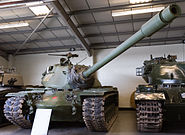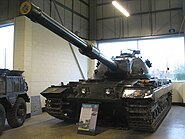| The Tank Museum | |
|---|---|
 The redeveloped museum, with control tower for the adjoining events area | |
|
| |
| Established | 1947 |
| Location |
Bovington, Dorset United Kingdom |
| Coordinates | 50°41′43″N 2°14′37″W / 50.695194°N 2.243611°W |
| Type | Military Museum |
| Public transit access | Wool railway station |
| Website | www.tankmuseum.org |
The Tank Museum (previously The Bovington Tank Museum) is a collection of armoured fighting vehicles at Bovington Camp in Dorset, South West England. It is about 1 mile (1.6 km) north of the village of Wool and 12 miles (19 km) west of the major port of Poole. The collection traces the history of the tank. With almost 300 vehicles on exhibition from 26 countries it is the largest collection of tanks and the second largest collection of armoured vehicles in the world.[Note 1] It includes the only working example of a German Tiger I tank and a British First World War Mark I, the world's oldest surviving combat tank.
It is the museum of the Royal Tank Regiment, Royal Armoured Corps and a registered charity.[1] Bovington Camp, in which the museum is located, trains most sections of the British Army in tracked-vehicle driving as well as repairing and maintaining the vehicles in its workshops.
History[]

A German Panther tank in the World War II hall
In 1916 the British War Office established the Bovington camp as a tank crew training facility. At that time the Army was introducing tanks into the First World War in an attempt to break the stagnation of trench warfare. In 1919 the tanks returned to Bovington from France. Many of them were fit only for scrap. However, a small number of the least damaged vehicles were put to one side so that tank crews and designers could have an idea of the tank's early heritage.
In 1923 the writer Rudyard Kipling visited Bovington and recommended a museum should be set up. The collection grew greatly after the Second World War, as many Allied and captured Axis tanks were added. In 1947 it was opened to the general public. The Tank Museum has continued to expand and today it is primarily seen as a means of educating and entertaining the general public, with the exhibition being geared in this direction. Many of the tanks are in complete working order and can be seen in action throughout summer months in special displays.
The museum holds an annual TankFest display of their operating vehicles and visiting vehicles. In 2012, the museum's historian, an employee since 1982, David Fletcher was made an MBE "for his services to the history of armoured warfare".[2]
Exhibition halls[]

British Mark V. It saw action at the Battle of Amiens in August 1918.

Expansion work to provide an additional 5,000 square metres (54,000 sq ft) of space and modernised facilities was carried out 2008.[3]
- World War I Hall
Contains the whole British tank development from Little Willie to the Mark VIII "Liberty", plus an example of the British Mark V, one of the few World War I tanks still in working order. Also featured is an illustration of the life of the soldier and writer T. E. Lawrence, who lived at nearby Clouds Hill cottage and served in the Tanks Corps at Bovington for a short time.
- Also featured: Mark I, II, IV, V (female & male variants), VIII, and IX tanks.
- Inter War Hall
Highlights the rapid progress made in tank design and vehicle armour during the period leading up to World War II.
- Also featured: Vickers A1E1 Independent, Peerless Armoured Car, Rolls-Royce Armoured Car, Lanchester 6x4 Armoured Car, Carden Loyd tankette, Tank Light MK IIA, Cruiser Mk I.
- World War II Hall

Is the biggest section, with tanks from most nations involved in the conflict. It includes a German Tiger I tank bearing turret number 131. It was captured in Tunisia in April 1943 and has been fully restored to running condition by the workshops at Bovington. It is the only Tiger I left that is capable of running under its own power. It also has the last surviving DD Tank with its canvas screen, and the only one still in working order.[citation needed]
- Also featured: Panzer I, II, III, IV, Stug III, Panther, Tiger I, Tiger II, Jagdpanzer 38(t), Jagdpanther, Jagdtiger, SdKfz 251, FT-17, Char B1, Somua S35, Cruiser Mk III, Comet I, Matilda Mk I, Matilda II, Churchill Mk VII, TOG2, A33 Excelsior, A38 Valiant, T14 Assault tank, Ram Cruiser Mk II, M24 Chaffee, M3 Grant, M4 Sherman, Sherman Firefly, M10 Tank Destroyer, M48 Patton, M26 Pershing, T17 Staghound, Hamilcar glider, DUKW, SU-76, T-26, T-34, KV-1, SU-100, L3/33 LF, M13/40
- Tamiya Hall

Iraqi T-55
Sponsored by the scale-model manufacturer. It features post war Main Battle Tanks (MBT) such as the British Centurion, the American M60 and the Russian T-72.
- British Steel Hall
Highlights the Chobham armour used in the Gulf War against Iraq and pays tribute to the Centurion tank which, during its 46-year career (1945–1991), proved to be one of the best British tanks ever produced.
- The Tamiya and British Steel Halls are currently undergoing some reorganisation, but between them they usually feature: Tortoise, Black Prince, Conqueror, Charioteer tank destroyer, Centurion, Chieftain, Challenger 1, Challenger 2, M41 Bulldog, M103, M60 Patton, T-54, Cold-War and Iraqi T-55's, T-62, T-72, BMP-1, AMX-30, Type 69, Infanterikanonvagn 91, Stridsvagn 103, Stridsvagn 104.
Gallery[]
See also[]
- Tank museums
- Cavalry Tank Museum — India
- Kubinka Tank Museum — Russia
- Musée des Blindés — France
- Deutsches Panzermuseum — Germany
- Patton Museum of Cavalry and Armor — United States
- Yad La-Shiryon - Israel
- Parola Tank Museum - Finland
- Other
- United States Army Ordnance Museum
- Polish Army Museum — large collection of Soviet, western and Polish AFVs.
- Heartland Museum of Military Vehicles Nebraska, USA.
- Base Borden Military Museum Ontario Canada
- Lists of armoured fighting vehicles
- Tank classification
Notes[]
- ↑ The Musée des Blindés in France has a collection of 880 armoured vehicles, although it includes fewer tanks than Bovington.
References[]
External links[]
| Wikimedia Commons has media related to The Tank Museum. |
- Tank Museum website
- Tiger Tank restoration website
- Rio de Janeiro's military vehicle modeling association - Extensive collection of photos taken inside the Museum
The original article can be found at The Tank Museum and the edit history here.















